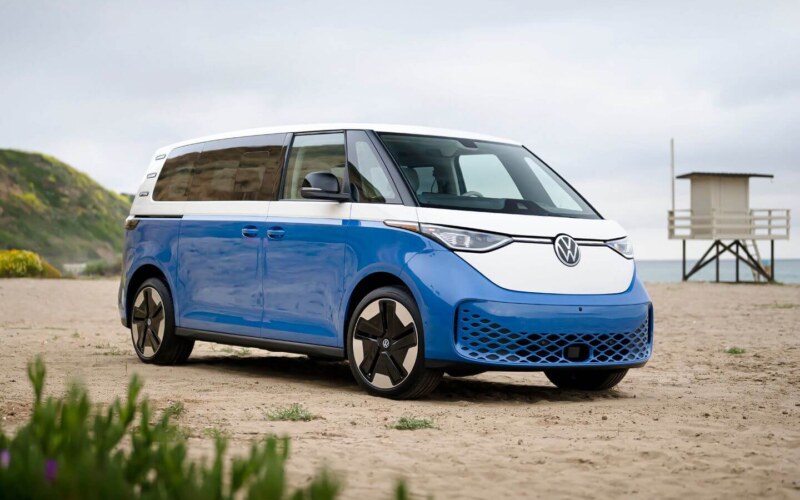- Home
- Volkswagen
- Volkswagen ID. Buzz (three-row) GTX 2024
Volkswagen ID. Buzz (three-row) GTX 2024 : Price, Range, Specs, and Features

The Volkswagen ID. Buzz GTX 2024 revives the iconic Microbus spirit with a modern electric twist, blending retro charm with cutting-edge performance. As a three-row, seven-seater electric MPV, it’s designed for families craving space, style, and zero-emissions driving. But does this long-wheelbase (LWB) GTX variant deliver on its promises, or does its premium price tag overshadow the fun? In this comprehensive review, we’ll dive into the specs, features, pricing, pros, and cons to help you decide if the ID. Buzz GTX is the ultimate electric family hauler.
Whether you’re searching for “Volkswagen ID. Buzz GTX 2024 review” or “best three-row electric vans“, this guide covers everything from acceleration to cargo space, ensuring you’re equipped for your next EV adventure.
Design and Exterior: A Nostalgic Nod to the Classic VW Bus
The 2024 ID. Buzz GTX pays homage to the original 1960s VW Bus while embracing futuristic EV aesthetics. Its boxy silhouette, two-tone paint options, and signature round headlights scream retro cool, making it a standout in a sea of sleek SUVs. The LWB three-row version stretches to 4,982 mm in length, 2,211 mm wide, and 1,937 mm tall, providing ample presence on the road without feeling cumbersome in urban settings.
- Optional two-tone paint: Adds up to £3,000 but enhances the vintage vibe.
- Panoramic sunroof: Standard on higher trims, flooding the cabin with light.
- 19-inch alloy wheels: GTX-specific with aerodynamic covers for better efficiency.
This design isn’t just eye candy—it’s practical too, with a low step-in height for easy family access and sliding doors (optional) for tight parking spots. Compared to rivals like the Kia EV9 or Peugeot E-5008, the Buzz GTX feels more approachable and fun, turning heads at school runs or road trips.
Performance and Driving Dynamics: Punchy Power with Family-Friendly Poise
Under the hood—or rather, the floor—the ID. Buzz GTX packs dual electric motors delivering 340 PS (250 kW) and 413 lb-ft of torque, paired with Volkswagen’s 4MOTION all-wheel drive. This setup propels the LWB three-row model from 0-62 mph in 6.7 seconds, a respectable sprint for a 2.7-tonne family van.
Powered by an 86 kWh battery (net capacity), it offers an official WLTP range of up to 291 miles, though real-world tests suggest around 240-250 miles with mixed driving and a full load. Efficiency hovers at 2.9-3.2 miles per kWh, making it competitive but not class-leading against the longer-range Kia EV9.
Charging is a breeze: Up to 200 kW DC fast-charging fills from 20-80% in just 20 minutes, while AC home charging at 11 kW takes about 8 hours for a full top-up. Towing capacity reaches 1,800 kg braked, ideal for trailers or bike racks.
On the road, the GTX shines with composed handling and a tight turning circle (thanks to rear-axle steering on LWB models), absorbing bumps like a luxury cruiser. However, its height and weight make it lean in corners, prioritizing comfort over sportiness. It’s a delightful daily driver for highways and city streets, with instant torque making overtakes effortless.
Interior and Space: Cavernous Comfort for Seven
Step inside the three-row ID. Buzz GTX, and you’re greeted by a spacious, adaptable cabin that seats seven in 2-2-3 configuration. The LWB body ensures generous legroom across all rows—adults fit comfortably in the third row, unlike crampier rivals. Cargo space starts at 306 liters with all seats up, expanding to 2,310 liters with the second and third rows folded or removed.
Premium touches include:
- GTX sport seats: With red stitching, memory functions, and heating/ventilation.
- Sliding center console: For flexible storage and cupholders.
- Multi-level boot floor: Creates a flat load area for camping gear.
Materials mix soft-touch surfaces with some scratchy plastics, giving it a premium-yet-practical feel. Ambient lighting and optional wood-effect trims add warmth, evoking the classic Bus’s bohemian roots. Families will love the ISOFIX points on outer second-row seats and the easy-fold mechanisms for reconfiguring space on the fly.
Technology and Safety: Smart Features with a Few Hiccups
The ID. Buzz GTX’s tech suite is packed with family-friendly goodies. A 12.9-inch infotainment touchscreen runs Volkswagen’s updated ID. software 5.2, integrating ChatGPT-powered voice assistant “IDA” for natural commands like “Find the nearest EV charger.” Wireless Apple CarPlay and Android Auto are standard, alongside a 30-color ambient lighting system.
Safety tech is robust, earning a five-star Euro NCAP rating:
- Adaptive cruise control with lane centering.
- Front and rear parking sensors with a 360-degree camera.
- Blind-spot monitoring and emergency assist.
However, the haptic steering wheel controls remain fiddly, requiring drivers to glance away—a common gripe in VW EVs. Wireless charging and USB-C ports abound, but the third-row lacks dedicated climate vents, which could annoy on long trips.
Pricing and Ownership Costs: Premium Price for Iconic Appeal
The 2024 Volkswagen ID. Buzz GTX three-row starts at around £68,000 in the UK (or €75,000 in Europe), positioning it as a luxury buy rather than a budget EV. In the US, the 2025 equivalent (Pro S Plus 4Motion) begins at $69,545 before incentives like the $7,500 federal tax credit, bringing it under $62,000 for eligible buyers. Expect to add £2,000-£5,000 for options like the panoramic roof or heated seats package.
Running costs are low: No road tax in many regions, and home charging at 15p/kWh costs about £8 for a full 250-mile range. Volkswagen’s eight-year/100,000-mile battery warranty adds peace of mind, with a three-year/60,000-mile vehicle warranty standard.
Compared to the Kia EV9 (£65,000 starting) or Mercedes EQV (£70,000+), the Buzz GTX holds value through its unique styling, though resale might lag behind more conventional SUVs.
| Trim/Feature | Starting Price (UK) | Key Additions |
|---|---|---|
| ID. Buzz Life Pro (5-seat) | £60,005 | Base range, single motor |
| ID. Buzz Style (7-seat LWB) | £64,000 | Upgraded interior, longer body |
| ID. Buzz GTX (7-seat LWB) | £68,000+ | AWD, 340 PS, sport tuning |
Pros and Cons of the 2024 Volkswagen ID. Buzz GTX Three-Row
Pros:
- Iconic, head-turning design that blends nostalgia with modern flair.
- Expansive interior with flexible seating for seven and massive cargo potential.
- Strong performance from dual motors, with quick acceleration and confident handling.
- Fast charging and solid real-world range for family road trips.
- Loaded with tech, including AI voice control and premium safety aids.
Cons:
- High price point that stretches budgets compared to rivals like the Skoda Enyaq.
- Fiddly infotainment with haptic controls that distract from driving.
- Range falls short of top competitors in highway-heavy use.
- Weight impacts agility, leading to body lean in spirited corners.
- Third-row access can feel tight without sliding doors.
Final Verdict: Is the 2024 ID. Buzz GTX Worth It?
The Volkswagen ID. Buzz GTX three-row 2024 is more than an electric van—it’s a lifestyle statement for eco-conscious families who value fun, space, and heritage. Its punchy power and cavernous cabin make it a joy for daily duties and adventures alike, but the steep price and quirky tech might deter value hunters. If you’re after a Tesla Model Y alternative with soul, this Buzz delivers. For pure efficiency, look to the Kia EV9.
Ready to buzz into the future? Check local dealers for test drives and incentives. What’s your take—retro EV dream or overpriced novelty? Share in the comments!
*This review is based on 2024 European specs; US models may vary slightly for 2025 MY.*

Volkswagen ID. Buzz (three-row) GTX 2024 Images
Specs
Launch
| Announced | 2024, March 21 |
| Status | Available to order. Released 2024, September |
Body
| Type | 5 door Van, 6/7 seats |
| Dimensions | 4962 x 1985 x 1935 mm (195.4 x 78.1 x 76.2 in) |
| Drag coef. | 0.29 Cd |
| Wheelbase | 3239 mm (127.5 in) |
| Weight | EU: 2780 kg unladen, 4910 kg gross |
| Suspension | Front MacPherson strut, rear multi-link |
| Wheels | R20, R21 |
| Trunk | EU: 1340 l, 2469 l max |
| Frunk | No |
| Towing | EU: 750 kg unbraked, 1600 kg braked |
Performance
| Power | AWD 250 kW (340 hp) |
| Torque | 560 Nm (413 lb-ft) |
| Acceleration | 6.4 sec 0-100 km/h |
| Max speed | 160 km/h (99 mph) |
Battery
| Capacity | 86 kWh usable, 91 kWh total |
| Tech | Li-Ion NCM 383V (400V type) |
| Range | 473 km WLTP |
| Consumption | 20.2 kWh/100 km WLTP |
| Recuperation | Yes, via driving modes and driving profiles |
| Heat pump | Yes |
| AC Charging | Type 2 11 kW, 100% in 9 h |
| DC Charging | CCS 200 kW, 10-80% in 26 min |
Displays
| Center | 12.9" touchscreen |
| Driver's | 5.3" |
| Head-up | Yes |
Comfort
| Seats | Heated, ventilated, massage front seats, heated 2nd row seats |
| Roof | Panoramic glass sunroof, electrochromic tinting |
| Parking aids | 10 front and rear sensors, 360 camera, reversing camera, remote parking |
| Connectivity | Wireless Android Auto and Apple CarPlay |
Safety
| Airbags | Front, side, rear, center, head airbag system |
| Driving aids | Front radar, 2 rear corner radars, front & rear cameras. Front Assist Autonomous Emergency Braking with pedestrian and cyclist monitoring, Lane Assist, Dynamic Road Sign Display, Side Assist, Travel Assist, Emergency Assist, Park Assist, Light Assist, Area View |
Volkswagen ID. Buzz (three-row) GTX 2024 Price
 Price in USD
Price in USD
|
87,300 USD |
 Price in European Union
Price in European Union
|
74,205 EUR |
 Price in United Kingdom
Price in United Kingdom
|
64,602 GBP |
 Price in Australia
Price in Australia
|
133,569 AUD |
 Price in Canada
Price in Canada
|
120,474 CAD |
 Price in India
Price in India
|
7,621,290 INR |
 Price in China
Price in China
|
626,814 CNY |
 Price in Indonesia
Price in Indonesia
|
1,414,260,000 IDR |
 Price in Philippines
Price in Philippines
|
4,976,100 PHP |
 Price in Malaysia
Price in Malaysia
|
368,406 MYR |
 Price in Nigeria
Price in Nigeria
|
134,005,500 NGN |
 Price in Russia
Price in Russia
|
7,024,158 RUB |
 Price in Pakistan
Price in Pakistan
|
24,705,900 PKR |
 Price in Saudi Arabia
Price in Saudi Arabia
|
327,375 SAR |
 Price in Japan
Price in Japan
|
12,833,100 JPY |
 Price in South Africa
Price in South Africa
|
1,539,972 ZAR |
 Price in Brazil
Price in Brazil
|
474,039 BRL |
 Price in Bangladesh
Price in Bangladesh
|
10,563,300 BDT |
 Price in Mexico
Price in Mexico
|
1,638,621 MXN |












